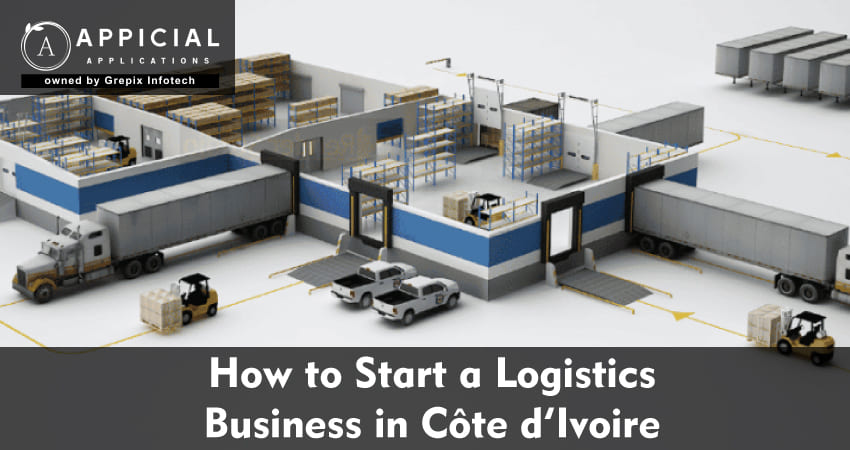
How to Start a Logistics Business in Côte d’Ivoire
When I first started thinking about the logistics business in Côte d’Ivoire, I was sitting in a small café in Cocody, watching delivery bikes dart between traffic. Some carried grocery bags, others stacks of cardboard boxes tied together with rope. I remember thinking, there’s a whole economy on two wheels here, and it’s not even scratching the surface of what’s possible.
That was 2022. Since then, the market has changed faster than I expected. Back then, I didn’t see Logistics App Development as the core of the business; I thought it was all about owning trucks and hiring drivers. I was wrong. In 2024, tech is the foundation.
The truth is, Côte d’Ivoire is in the middle of a logistics boom. You can feel it when you visit the Port of Abidjan: new cranes, more containers, foreign investors walking the docks with clipboards. Or when you drive the new stretch of highway between Yamoussoukro and San-Pédro, smoother, faster, fewer delays.
And while that’s exciting, it also means competition is heating up. If you’re going to start now, you need an edge. For me, that edge came from building a Logistics App that didn’t just track deliveries, it made the whole process transparent for clients and drivers.
Côte d’Ivoire’s logistics sector is on the move, literally and economically. Between the Abidjan port expansion, booming e-commerce, and stronger regional trade under AfCFTA, the demand for modern logistics solutions is exploding. This guide unpacks everything: why now is the perfect time to enter the market, what features a strong Logistics App must have, projected revenue growth to 2030, and real stories from Ivorian founders making it happen. Whether you want to operate as a 3PL Logistics Company, run Last Mile Delivery App services, or provide full Freight Transportation Services, this roadmap will help you get started.
Why Build a Logistics App in Côte d’Ivoire?
Before I go into the “how,” let me explain the “why.”
When I started talking to potential clients, small exporters in Treichville, supermarkets in Plateau, and even a few cocoa cooperatives up north, I heard the same complaints:
- “We don’t know where our goods are.”
- “Drivers don’t communicate until they arrive.”
- “We can’t track costs.”
At first, I thought this was just bad management. But then I realised that most local operators still rely on phone calls and WhatsApp messages to manage orders. That’s not sustainable for businesses moving thousands of shipments a month.
Here’s why I decided to focus on Logistics App Development:
- Regional trade growth: AfCFTA is removing trade barriers, and Côte d’Ivoire is right in the middle of it. Cross-border Freight Transportation Services are only going to increase.
- Urban demand: Abidjan’s population is growing fast. E-commerce is booming. Everyone wants Last Mile Delivery App services.
- Mobile money dominance: Orange Money, MTN Mobile Money, and Moov are everywhere. Integrating them into the app meant instant payment options.
- Infrastructure projects: Every new road or port upgrade shortens delivery times, making logistics more attractive to customers.
One thing I learned quickly, in this market, the best Logistics Company isn’t always the one with the biggest fleet. It’s the one with the best tech.
What are the Essential Features of a Logistics App?
When I sat down with a Logistics App Development Company in Abidjan, they asked me a question that completely reframed my approach:
“What do your clients complain about the most?”
I gave them a list: late deliveries, no tracking, lost goods, and payment confusion. That became the blueprint for our app.
The features we built in:
- Real-time tracking: Clients can see the driver’s location, even in rural areas with a patchy network.
- Proof of delivery: Drivers take a photo and collect a digital signature.
- Payment integration: Mobile money, card, or cash.
- Route optimisation: The app reroutes drivers if traffic is bad.
- 3PL Warehouse integration: For larger clients who need storage.
One driver told me the GPS feature saved him during a night delivery in Yopougon when a road was blocked. The app rerouted him automatically, and he still delivered on time. That’s when I knew this was worth the investment.
What are the Opportunities in B2B and B2C Logistics?
At first, I thought B2C would be my main market, delivering groceries, clothes, and electronics. And yes, it’s growing fast. But what surprised me was the demand in B2B.
B2B opportunities:
- Cocoa exporters needing temperature-monitored transport.
- Breweries moving products to nationwide distributors.
- Factories needing Logistics Supply Chain Management for parts and raw materials.
B2C opportunities:
- Same-day delivery for e-commerce stores.
- Medicine delivery from pharmacies.
- Furniture and appliance transport.
One of my first B2B clients, a construction materials supplier, doubled its order volume with us after we implemented a Last Mile Delivery App tracking system. They told me they finally felt confident enough to promise same-day delivery to their customers.
What is the Cost of Logistics App Development?
Now, let’s talk money.
When I started, I didn’t know what an app would cost. I assumed $5,000 could get me something functional. I was way off.
Here’s the reality for Côte d’Ivoire in 2024–2025:
| Development Type | Cost (USD) | Timeframe |
|---|---|---|
| Basic MVP with tracking & payments | $20,000 – $30,000 | 3–4 months |
| Full-featured app with warehouse integration | $40,000 – $60,000 | 6–8 months |
| Enterprise platform with cross-border features | $70,000 – $100,000+ | 10–12 months |
It’s a serious investment. But in my case, it paid off, we broke even in 14 months because we targeted high-value contracts early.
What are the Case Studies & Regional Examples?
1 ColiRapide – Abidjan
Started with three vans in 2022, serving only food deliveries. By mid-2024, they became a 3pl Logistics Company handling corporate deliveries. Their secret? A Logistics App with client dashboards and automated invoices.
2 Kargo CI – Port of Abidjan
Specialised in Freight Transportation Services to Mali and Burkina Faso. They reduced empty return trips by 25% with Logistics Supply Chain Management software.
3 AgriLink – Northern Côte d’Ivoire
Transported fresh produce with mobile temperature sensors linked to their Logistics App. Farmers reported fewer spoilages and higher profits.
Côte d’Ivoire Logistics Market Projections
| Year | Total Market Value (USD) | Last-Mile Share | Cross-Border Share |
|---|---|---|---|
| 2025 | $3.8B | 22% | 39% |
| 2026 | $4.2B | 25% | 38% |
| 2027 | $4.6B | 27% | 37% |
| 2028 | $5.0B | 29% | 36% |
| 2029 | $5.5B | 31% | 35% |
| 2030 | $6.0B | 33% | 34% |
How Appicial Applications Helped Me?
I worked with Appicial because they understood the local market. They built offline mode into the Logistics App, which was crucial for routes with poor connectivity. They also customised the dashboard so my drivers could switch between French and Baoulé.
What impressed me most was their ability to scale. When I needed to integrate 3PL Warehouse tracking, it didn’t require rebuilding the whole system.
Conclusion
If you’re thinking about starting a logistics business in Côte d’Ivoire, here’s my honest advice:
- Don’t wait for the “perfect” time: the market is growing now.
- Start with a solid Logistics App: It will be your biggest asset.
- Look beyond Abidjan: Regional hubs like Bouaké and San-Pédro are growing fast.
I’m still learning every day. But I can tell you this: in this market, the Best Logistics Company isn’t necessarily the one with the most trucks. It’s the one that delivers reliability and that starts with tech.
FAQs
Author's Bio

Vinay Jain is the Founder at Grepix Infotech and brings over 12 years of entrepreneurial experience. His focus revolves around software & business development and customer satisfaction.
Back to blog list




